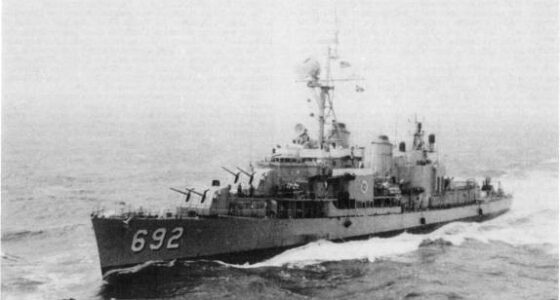The USS Allen M. Sumner (DD-692) exemplified American naval superiority across three major conflicts during her nearly thirty-year career from 1944 to 1973. This Fletcher-class destroyer served with distinction in multiple World War II Pacific campaigns, Korean War operations, Cold War tensions, and Vietnam combat duty, but her history also includes exposing thousands of Navy veterans and shipyard workers to the asbestos that was commonly used in ship construction during that time. Many of those individuals were later diagnosed with mesothelioma and other serious diseases, and those who were crew members in her later years are still at risk.

About the USS Allen M. Sumner
The Allen M. Sumner (DD-692) was named for Allen Melancthon Sumner, a Marine Corps Captain who was killed by German shellfire while leading his troops in the First World War. He was posthumously awarded the French Croix de Guerre with star for saving the lives of many of his men without regard for his own safety. The Allen M. Sumner is the second Navy vessel named for Captain Sumner; the first was USS Sumner (DD-333), which was decommissioned in 1930. Because another naval vessel carried the name Sumner in honor of Captain Thomas Hubbard Sumner USN when DD-692 was being built, this ship was given the full name Allen M. Sumner.[1]
The Allen M. Sumner was the first of a class of destroyers that were larger and more heavily armed than their predecessors. She measured 376 feet in length, weighed 2,200 tons standard and 3,315 tons fully loaded, and was designed to engage larger Japanese destroyers. The ship carried a complement of 20 officers and 325 enlisted men (270 during her Vietnam deployment) and was equipped with four Babcock & Wilcox boilers and two Westinghouse turbine sets. She was able to attain speeds of 36.5 knots at standard displacement and initially carried an armament that included three 5 in/38 twin mounts, two quad (3 in 1945), two dual 40 mm mounts, and ten single 20mm mounts. Later overhauls removed that weapons system and replaced it with new equipment, including a torpedo tube battery, a drone anti-submarine helicopter, and a depth charge projector battery.[2]
Construction and Early Service
Built by Federal Shipbuilding & Drydock Company in Kearny, New Jersey, the Sumner was laid down in July 1943 and launched in December of the same year. She was sponsored by Captain Sumner’s widow and commissioned in January 1944, under Commander Norman J. Sampson.[2]
Operational and Deployment History
Following shakedown training near Bermuda and post-commissioning work in New York, the Allen M. Sumner spent two months training destroyer crews at Norfolk before departing for the Pacific theater in August 1944. Her journey included escorting the battleships Alaska and Missouri through the Panama Canal.
World War II
In November 1944, the Allen M. Sumner joined the Fast Carrier Task Force in the western Pacific, participating in carrier air strikes against Japanese positions in the Philippines. She engaged a Japanese “Betty” bomber and hit it with her heavy machine guns, causing the aircraft to burst into flames, but the destroyer’s most significant World War II action occurred during the Battle of Ormoc Bay in December 1944. Accompanying the destroyers Moale and Cooper to intercept a Japanese reinforcement convoy, she faced intense combined attacks from air, surface, submarine, and shore-based forces. The Allen M. Sumner was damaged by a bomb that wounded thirteen crew members. The American destroyers successfully sank a Japanese destroyer, but the Cooper was torpedoed and sunk, with many crewmembers lost.
Later, Sumner supported the Mindoro landings in December 1944 and participated in the Lingayen Gulf invasion in January 1945, when a kamikaze aircraft crashed into the ship, killing sixteen men and wounding twenty-seven. Despite extensive damage, Sumner remained operational and continued supporting the invasion until mid-January.
Following repairs at Hunters Point Naval Shipyard in San Francisco, Sumner returned to the Pacific in August 1945, arriving just after the Japanese surrender. She escorted the USS Missouri during the surrender ceremony in Tokyo Bay.[2]
Post-War and Korean War Service
After supporting the 1946 atomic bomb tests at Bikini Atoll, the Allen M. Sumner conducted training operations and was deployed on an extended Far East cruise in 1947. In 1949, she transferred to the Atlantic Fleet and began a pattern of alternating East Coast operations with Mediterranean deployments.
The Allen M. Sumner only had one combat deployment to the Korean conflict. Arriving in Japan in June 1953, she served as plane guard and antisubmarine screening ship for fast carriers conducting strikes against North Korean targets. Her crew rescued downed airmen, including pilot Lieutenant Clarence R. Johnson and crew member ACAN D.G. Kennedy, after their aircraft crashed. Sumner was still on station when the armistice ended hostilities.[2]
Cold War Operations and Modernization
Throughout the 1950s and early 1960s, Sumner maintained an active schedule of Atlantic and Mediterranean operations. She participated in NATO exercises in northern European waters, including operations north of the Arctic Circle. She also conducted independent duty missions in the Persian Gulf and western Indian Ocean.
The ship underwent significant upgrades during this period, including the replacement of her 40mm guns with modern 3″/50 caliber weapons in 1952 and the installation of advanced submarine detection equipment. In 1961-1962, she underwent a Fleet Rehabilitation and Modernization (FRAM) overhaul that dramatically improved her antisubmarine warfare capabilities.
During the 1962 Cuban Missile Crisis, the Allen M. Sumner and the William C. Lawe were the first warships to be stationed off the coast of Cuba during President Kennedy’s quarantine.[2]
Vietnam War
The Allen M. Sumner saw her final major combat service during her Vietnam deployment from February to September 1967. Operating under the call sign “Road Block,” she completed multiple missions including radar picket duty, “Sea Dragon” interdiction operations against communist supply lines, and shore bombardment support.
Her most intense engagement came during Operation “Beau Charger” near the demilitarized zone, when she fired over 1,100 rounds of 5-inch ordnance in 24 hours. This was the ship’s record. Throughout the deployment, she destroyed or damaged 107 waterborne logistics craft, eight coastal defense sites, ten trucks, and sixteen buildings. She also rescued an Air Force pilot, First Lieutenant Ronnie E. Randolph.
The Allen M. Sumner’s Vietnam service earned her the Meritorious Unit Commendation. The ship was also recognized for setting an unofficial record for the most waterborne logistics craft destroyed by a single destroyer in the Vietnam campaign.[2]
Final Years and Decommissioning
Sumner’s final years involved continued operations from Mayport, Florida, including support for the Guantanamo Bay naval base during the late 1960s. In 1969, she participated in NATO’s 20th anniversary review and was personally inspected by Queen Elizabeth II.
The ship’s last Mediterranean deployment in 1970-1971 earned her another Meritorious Unit Commendation for service during the Jordanian Crisis, including a twelve-hour submarine tracking operation against a Soviet “N” class submarine.
In July 1971, Sumner was assigned to Naval Reserve training duties in Baltimore, marking the end of her frontline service. She was decommissioned in August 1973 at Philadelphia Naval Shipyard and sold for scrapping in 1974.[2]
Asbestos Exposure on the USS Allen M. Sumner
From before the 1930s to the 1970s, Navy ships like the USS Allen M. Sumner were built and outfitted with asbestos. The material was used in multiple sections and applications because its heat-resistance, ability to prevent items from catching fire, and strength made it seem perfectly suited to the seafaring environment. The Allen M. Sumner was typical in being both constructed with asbestos and later having the material removed and new asbestos installed during later repairs and upgrades.
Each time these types of activities were performed, tiny particles of asbestos were released into the air where they could be breathed in, ingested, or land on shipyard workers’ hair, skin, or clothing to be carried into their homes, leading to secondary asbestos exposure. The material and the activities surrounding it created serious health dangers that were unrecognized by the Navy, and kept secret by those asbestos companies that had been informed of the health hazards.
The greatest concentrations of asbestos-containing materials were found in:
- Engine areas: Machine rooms had asbestos wrapping around boilers, turbines, pumps, and valves. Heat-resistant blankets, seals, and packing materials used in these locations also contained large amounts of asbestos.
- Power plant systems: The Allen M. Sumner’s had thousands of feet of steam pipes, exhaust systems, and condensers used fire-resistant wrapping that was mostly composed of asbestos.
- Electrical equipment: Electrical wiring, control panels, and parts were frequently insulated with asbestos because of its fire-resistant and non-conductive qualities.
- Living quarters and shared spaces: Crew quarters and mess areas contained asbestos floor tiles, ceiling materials, wall padding, and fire-resistant doors.
- Fire safety gear: Protective equipment used by damage control and firefighting teams frequently contained asbestos for heat and flame protection.
Who Faced the Highest Risk of Asbestos Exposure on the USS Allen M. Sumner?
While every sailor on the USS Allen M. Sumner was potentially exposed to asbestos, certain job duties placed crew members at much higher risk.
The crew members who were most at risk of abestos exposure included:
- Machinist’s Mates
- Boiler Technicians
- Hull Maintenance Technicians
- Damage Control Personnel
- Pipefitters
- Electricians
- Shipyard Workers
The conditions aboard the destroyer were cramped and had poor air circulation, which made exposure risks worse. Because asbestos particles are so lightweight, once they’re airborne, they can remain suspended in the air for long periods, increasing the chance of spreading throughout the ship to be inhaled or to rest on surfaces. This is why even crew members who didn’t work directly with the dangerous material were exposed.
Health Effects for USS Allen M. Sumner Veterans
Asbestos exposure can cause serious and often deadly health problems, with symptoms of some asbestos-related illnesses not showing up until 20 to 50 years later. This long delay — known as a latency period — means that many USS Allen M. Sumner veterans have only recently begun having symptoms related to their service decades ago, and others may still be diagnosed in the future.
Common asbestos-related diseases affecting Navy veterans include:
- Pleural and Peritoneal Mesothelioma
- Asbestosis
- Lung Cancer
- Pleural Plaques and Thickening
- Other Cancers
The development of these diseases can be devastating for veterans and their families, causing significant grief, reduced quality of life, medical costs, and early death.
Compensation and Support for Veterans Who Served on the USS Allen M. Sumner
Veterans who served on the USS Allen M. Sumner and developed asbestos-related diseases have several options available for compensation and support. The Department of Veterans Affairs acknowledges that asbestos exposure during service created risk, and eligible veterans can receive disability payments; expert medical care at VA medical centers or specialized cancer treatment facilities across the country; and additional support services including home healthcare, adaptive equipment, and help for family caregivers. Mesothelioma usually qualifies for a 100% disability rating, providing the highest benefit amount.
To qualify for these benefits, veterans need to prove that their condition is linked to asbestos exposure during military service. This process can be difficult, often requiring detailed records of service history, job duties, and medical proof connecting the illness to asbestos exposure.
Another option for payment for military veterans is through asbestos trust funds set up by bankrupt companies that made asbestos products to pay asbestos victims. Together, these funds hold billions of dollars. Like VA benefit claims, they also require proof of asbestos exposure to their products and medical evidence of an asbestos-related diagnosis.
Finally, veterans diagnosed with mesothelioma can also file legal claims against the companies that made, sold, or installed asbestos-containing products on naval ships through personal injury lawsuits. A successful lawsuit can provide payment for medical costs, lost wages, pain and suffering, and other damages. Similarly, wrongful death claims for loss of companionship, funeral costs, and other damages can be filed by family members who have lost a loved one to an asbestos-related illness.
Pursuing any of these forms of payment can be difficult. Veterans and their family members will significantly benefit from working with asbestos lawyers who are dedicated to helping mesothelioma victims file lawsuits, trust fund claims, and VA claims.
Mesothelioma lawyers have significant resources to help identify all potentially responsible asbestos companies. They can evaluate your eligibility for each type of compensation program, document the connection between your naval service and your asbestos exposure, and gather important medical evidence supporting your claim. They can also help you navigate the complex filing procedures and deadlines and represent your interests in negotiations and court proceedings.
By working with knowledgeable advocates, USS Allen M. Sumner veterans can maximize their chances of receiving fair payment and reducing stress associated with the complicated process.
References
- U.S.S. Allen M. Sumner (DD-692) (N.D.). Captain Allen Melancthon Sumner, USMC
Retrieved from: https://www.dd-692.com/allen_m__sumner.htm - U.S.S. Allen M. Sumner. (N.D.). Ship’s History.
Retrieved from: https://www.dd-692.com/history.htm

Terri Heimann Oppenheimer
WriterTerri Oppenheimer has been writing about mesothelioma and asbestos topics for over ten years. She has a degree in English from the College of William and Mary. Terri’s experience as the head writer of our Mesothelioma.net news blog gives her a wealth of knowledge which she brings to all Mesothelioma.net articles she authors.

Dave Foster
Page EditorDave has been a mesothelioma Patient Advocate for over 10 years. He consistently attends all major national and international mesothelioma meetings. In doing so, he is able to stay on top of the latest treatments, clinical trials, and research results. He also personally meets with mesothelioma patients and their families and connects them with the best medical specialists and legal representatives available.


